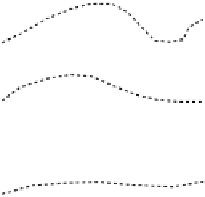Geoscience Reference
In-Depth Information
Fig. 7.11
Alternating layers of
sand and organic debris deposited
by four successive tsunami waves
of diminishing height in
Kvennavatnet Lake basin near
Bjugn, Norway, following the
second Storegga Slide. From
Fig. 6 in Bondevik et al. (
1997a
).
The photograph is Blackwell
Publishing Ltd. and is reproduced
by permission
0
Post-tsunami fallout
of silt and algae
(gyttja)
Silt lamina
5
Organic mash bounded
by sand laminae
Organic mash
10
Wave 4
Fine sand
Organic mash with
moss and twig pieces
Fine-medium sand
with marine forams
and shell pieces
Wave 3
15
Plant fragments in
gyttja and silt
20
Poorly sorted medium
sand with 50% shell
Wave 2
Plant fragments mixed
with silt, sand, and shell
25
Coarse sand and large
mollusc fragments
Wave 1
30
Laminated lake silt
Laminated marine silt
coasts. Indeed, bedrock-sculptured features and tsunami-
respectively are present along the east coast of Scotland in
the Edinburgh area and prominently along the Grampian
coastline north of Aberdeen (Fig.
7.10
). Ironically, many of
these features are similar to those originally described by
Hall in his ill-fated hypothesis. For example, a raised fluted
rock drumlin is cut into Carboniferous sandstone on the
low-tide platform at St. Andrews (Fig.
7.12
). The crest of the
feature lies 2 m above high tide and over 150 m from the
backing cliff. Although weathered, the sides of the flute still
preserve the distinct form of cavettos, while the upper surface
is imprinted with muschelbrüche (scalloped-shaped depres-
sions) aligned parallel to the alignment of features. Trans-
verse troughs, formed by roller vortices, have been carved
out from the surrounding platform and are not only aligned
with the strike of the sandstone beds, but also perpendicular
to the rock drumlin alignment. The platform surface rather
than being planed by storm waves has a relief of 0.4-0.6 m,
dominated by rock plucking that forms smaller flutes aligned
parallel to the main feature.
Similar, but more effective, erosion with large-scale
development of fluted promontories is most prominent
along the Grampian coastline between Fraserburgh and
Logie Head. The sand layer deposited by the Second Stor-
egga Tsunami reaches its maximum thickness, 75 cm, along
the coast at Fraserburgh. Platforms and promontories have
been cut into sandstones and metamorphic slates, phyllites,
and schists. One of the better examples of large-scale
sculpturing occurs at MacDuff. Here, bedrock has been
shaped into large rock drumlins or flutes rising 7-8 m above
the high-tide line (Fig.
7.13
). The drumlins are dominated
by profuse rock plucking, are detached from each other and
the backing cliff, and rise en echelon landward, where they



































































